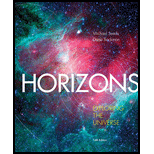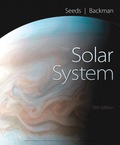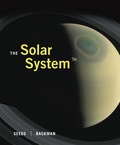
Horizons: Exploring the Universe (MindTap Course List)
14th Edition
ISBN: 9781305960961
Author: Michael A. Seeds, Dana Backman
Publisher: Cengage Learning
expand_more
expand_more
format_list_bulleted
Textbook Question
Chapter 19, Problem 4RQ
Why do astronomers refer to carbonaceous chondrites as unmodified or “primitive” material?
Expert Solution & Answer
Want to see the full answer?
Check out a sample textbook solution
Students have asked these similar questions
The ratio of charon to pluto's roche limit? or
How close is Charon to Pluto's Roche limit?
please solve accurate and exact
If the velocity of the solar wind is about 4.0 ✕ 102 km/s and the visible tail of a comet is 5.0 ✕ 108 km long, how many days does an atom in the solar wind take to travel from the nucleus to the end of the visible tail? (Note:1 day = 86,400 seconds.)
Chapter 19 Solutions
Horizons: Exploring the Universe (MindTap Course List)
Ch. 19 - What do Widmanst?tten patterns indicate about the...Ch. 19 - What do chondrules tell you about the history of...Ch. 19 - Why are there no chondrules in achondritic...Ch. 19 - Why do astronomers refer to carbonaceous...Ch. 19 - Prob. 5RQCh. 19 - Prob. 6RQCh. 19 - Why do astronomers think the asteroids were never...Ch. 19 - Prob. 8RQCh. 19 - What evidence indicates that some asteroids have...Ch. 19 - What evidence indicates that some asteroids have...
Ch. 19 - Prob. 11RQCh. 19 - What is the difference between a gas tail and a...Ch. 19 - Prob. 13RQCh. 19 - What are the hypotheses for how the bodies in the...Ch. 19 - Prob. 15RQCh. 19 - Prob. 1DQCh. 19 - Do you think the government should spend money to...Ch. 19 - Prob. 1PCh. 19 - If a single asteroid 1 km in diameter were to be...Ch. 19 - If a trillion (1012) asteroids, each 1 km in...Ch. 19 - Prob. 4PCh. 19 - What is the maximum angular diameter of the...Ch. 19 - Prob. 6PCh. 19 - Prob. 7PCh. 19 - Prob. 8PCh. 19 - What is the orbital period of a comet nucleus in...Ch. 19 - The mass of an average comet’s nucleus is about...Ch. 19 - Prob. 1LTLCh. 19 - Prob. 2LTLCh. 19 - Prob. 3LTL
Additional Science Textbook Solutions
Find more solutions based on key concepts
You have a summer job at your universitys zoology department, where youll be working with an animal behavior ex...
Essential University Physics: Volume 1 (3rd Edition)
Using the definitions in Eqs. 1.1 and 1.4, and appropriate diagrams, show that the dot product and cross produc...
Introduction to Electrodynamics
The increase in temperature in the case of kelvins, if it is increased by 1000°C .
College Physics: A Strategic Approach (3rd Edition)
Is Earths inner core solid and the outer core liquid because the inner core is cooler than the outer core? Expl...
Conceptual Integrated Science
56. Global Positioning System. Learn more about the global positioning system and its uses. Write a short repo...
The Cosmic Perspective
What class of motion, natural or violent, did Aristotle attribute to motion of the Moon?
Conceptual Physics (12th Edition)
Knowledge Booster
Learn more about
Need a deep-dive on the concept behind this application? Look no further. Learn more about this topic, physics and related others by exploring similar questions and additional content below.Similar questions
- Why is it more useful to classify meteorites according to whether they are primitive or differentiated rather than whether they are stones, irons, or stony-irons?arrow_forwardWhat methods do scientists use to distinguish a meteorite from terrestrial material?arrow_forwardExplain the role of impacts in planetary evolution, including both giant impacts and more modest ones.arrow_forward
- How would studying the chemical composition of only the largest, brightest, and most easily observed asteroids yield potentially misleading information about asteroids in general? Why is this called a selection effect?arrow_forwardWhat is the difference between a centaur and a NEO?arrow_forwardWhat evidence indicates that some asteroids once had geologically active surfaces?arrow_forward
- What evidence shows that Venus has been resurfaced within the past half-billion years?arrow_forwardConsider the differentiated meteorites. We think the irons are from the cores, the stony-irons are from the interfaces between mantles and cores, and the stones are from the mantles of their differentiated parent bodies. If these parent bodies were like Earth, what fraction of the meteorites would you expect to consist of irons, stony-irons, and stones? Is this consistent with the observed numbers of each? (Hint: You will need to look up what percent of the volume of Earth is taken up by its core, mantle, and crust.)arrow_forwardSuppose a new primitive meteorite is discovered (sometime after it falls in a field of soybeans) and analysis reveals that it contains a trace of amino acids, all of which show the same rotational symmetry (unlike the Murchison meteorite). What might you conclude from this finding?arrow_forward
arrow_back_ios
arrow_forward_ios
Recommended textbooks for you

 Foundations of Astronomy (MindTap Course List)PhysicsISBN:9781337399920Author:Michael A. Seeds, Dana BackmanPublisher:Cengage Learning
Foundations of Astronomy (MindTap Course List)PhysicsISBN:9781337399920Author:Michael A. Seeds, Dana BackmanPublisher:Cengage Learning
 AstronomyPhysicsISBN:9781938168284Author:Andrew Fraknoi; David Morrison; Sidney C. WolffPublisher:OpenStax
AstronomyPhysicsISBN:9781938168284Author:Andrew Fraknoi; David Morrison; Sidney C. WolffPublisher:OpenStax Horizons: Exploring the Universe (MindTap Course ...PhysicsISBN:9781305960961Author:Michael A. Seeds, Dana BackmanPublisher:Cengage Learning
Horizons: Exploring the Universe (MindTap Course ...PhysicsISBN:9781305960961Author:Michael A. Seeds, Dana BackmanPublisher:Cengage Learning


Foundations of Astronomy (MindTap Course List)
Physics
ISBN:9781337399920
Author:Michael A. Seeds, Dana Backman
Publisher:Cengage Learning


Astronomy
Physics
ISBN:9781938168284
Author:Andrew Fraknoi; David Morrison; Sidney C. Wolff
Publisher:OpenStax

Horizons: Exploring the Universe (MindTap Course ...
Physics
ISBN:9781305960961
Author:Michael A. Seeds, Dana Backman
Publisher:Cengage Learning
Kepler's Three Laws Explained; Author: PhysicsHigh;https://www.youtube.com/watch?v=kyR6EO_RMKE;License: Standard YouTube License, CC-BY